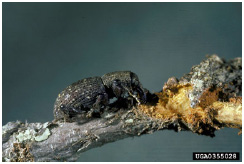INTRODUCTION
Insects, diseases, and weeds commonly reduce growth and survival of trees and forests throughout the United States. For example, damage and mortality in southern forests in 2000 due to insect pests alone have been conservatively estimated at nearly $487 million.
In the past, forest pest problems have been addressed largely by the research and pest management branches of the USDA Forest Service (USFS). Changes in forest policy on federal land and personnel within the USFS have shifted the objectives of public land management largely away from commercial timber production.
Goals for public land, and priorities for federally-funded research, are being directed more toward ecosystem management, maintenance of biodiversity, wilderness, wildlife management, recreation, and protection of endangered species. Forest management on federal lands in the future will emphasize natural regeneration, longer rotations, diversity of tree species, and uneven-aged management.
|
Pales Weevil (Hylobious pales) feeding on pine seedling |
Owners of private commercial forests, including Timber Investment Management Organizations (TIMOs) and Real Estate Investment Trusts (REITs), in contrast, are focusing increasing efforts on intensively-managed, short-rotation pine and hardwood plantations as a means to meet current and future demands for forest products. As the intensity of forest management increases, greater insect and disease problems are likely to be encountered. Reduced growth and tree mortality due to various pests, often tolerated in natural stands, cannot be ignored in high-value plantations.
In light of these changing trends and to address the continued need for applied research and technology development on forest and urban tree pests, the Forest Pest Management Cooperative (FPMC, formerly the Western Gulf Forest Pest Management Cooperative) was established in 1996. As of 2016, FPMC members total 10, including five full members, four associate members, and one supporting member.
In recent years, the FPMC has expanded its applied research to include pests such as oak wilt, hypoxylon canker, and the invasive soapberry borer affecting urban trees and forests. This allows the FPMC to also address pest concerns faced by the 80% portion of the citizenry who reside in urban areas of the South.
MISSION AND VISION OF THE FOREST PEST MANAGEMENT COOPERATIVE
“The mission of the Forest Pest Management Cooperative (FPMC) is to conduct research on commercial and urban forest pest problems with emphasis on those pests that members deem important, develop pest management recommendations, and transfer information and technology to members.”
Our Vision is: “To be the primary source of information and solutions for the forest pest problems that members encounter.”
|
